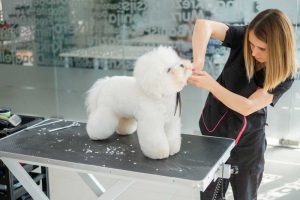Bichon Care
Caring Tips
How do I house train my Bichon?
The use of a crate is the best method to ensure success. This means the pet is crated whenever they are unattended, including nights, until they can be counted on to not have “accidents” in the house.
As to the mischief (meaning at least moderately destructive behavior to furniture and drapes), you will find the the same crate will be handy to prevent the chewing that pups go through when teething.

What about all this hair?
You probably learned before purchasing your pet that this is a breed that needs a lot of grooming! You can learn to take care of the coat entirely at home or you can combine home care with professional grooming. Bichons do not shed and their hair grows constantly. Regardless of which choice you make, daily or weekly brushing and combing is desirable to keep the coat free of mats (which can lead to additional skin problems). Bathing, blow drying the coat and scissoring can be done monthly or as needed but the daily care is up to YOU!
What else can I do to keep him happy and healthy?
Every dog benefits from obedience training. There are books available for home training but a short obedience course with a qualified training instructor can make a difference in many ways. Bichons are “show-offs” and love to perform. The work they do in obedience becomes a game – but the obedient dog is also a safer dog! Bichons are a very fast little breed (a fenced yard is also a good thing) and the trained dog is less likely to run into the street.
Will my puppy stay very friendly?
The natural temperament of Bichon Frises is to be outgoing and friendly (though they may initially seem somewhat aloof in some situations). The puppy that is fearful, extremely shy or shows any sign of aggression is not exhibiting typical Bichon behavior! These Bichons need obedience training and careful socialization and can usually be taught to trust. The earlier the training, the better. Forceful correction is not appropriate but neither is cuddling the pet and allowing it to shrink into the arms of the owner. The idea is to socialize them until they learn that their world is safe and obedience training is a good start. Puppy kindergarten is an excellent beginning and should be investigated very early for all pups.
Your primary goal is to get your new pup off to a good start by attending to his needs:
- proper health care
- good diet and plenty of fresh water
- proper grooming
- training for the pup’s safety and your increased enjoyment of your pet
Keep your Bichon safe and healthy, train them well and maintain their skin, teeth and coat. In return, they will be your loving companion, trusting friend and let you know when company arrives. Bichons are great conversationalists and love to entertain. What more can you ask for?
Should my puppy have a playmate?
If he is left alone a lot, a friend would fill the lonely hours. For ease of training, the pups should be of different ages (train the first before to teach the other). Obviously, you will want to neuter both at the earliest possible age to avoid health problems and “marking” territory – and these dainty little girls will occasionally “mark” unless spayed.
What is the origin of the Bichon?
The Bichon is of Mediterranean ancestry, descending from the Barbet or Water Spaniel, and is related to the Maltese. They are not part Poodle. Bichons have been a distinct breed since about 1400. A few Bichons came to this country in the 1950s, primarily from France and Belgium. The Bichon Frise Club of America was founded in 1964 and the breed recognized by the American Kennel Club in 1972. The Bichon is a strong competitor in the Non-Sporting Group and has proven to be an excellent competitor in the new Agility competition! The sturdy, muscular, and sound Bichon is quite athletic and you should expect this “lap dog” to give you a good time with his playful antics.
What else should I know about my Bichon?
The Bichon Frise is a fluffy white dog, though there may be some touches of buff or apricot on a puppy. This will usually fade with time. Lips, eye rims, halos, and foot pads are preferably black. They should stand 9 1/2 to 11 1/2 inches at the shoulder as an adult and will weigh about 10 to 16 pounds, unless much smaller or much larger than the standard calls for. A quality grain-free dog food is acceptable, though a raw diet in preferable. Over- or underweight dogs are less likely to stay healthy, so lots of extra treats are not a good idea! Access to a bowl of freshwater is essential.